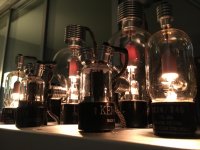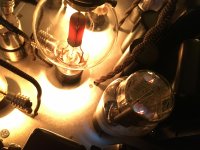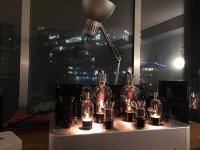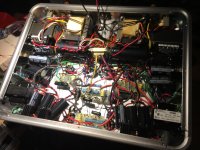Sorry this took me three and a half years to build. Anyway, here it is. Huge thanks to this forum and to Rod for his DHT regulators. The thing sounds great.
You guys were all really helpful and I can't wait to build whatever comes next.
PS, yeah, don't touch the caps. Seriously.
Steve , Very Nice .......
I'll post some more tonight, no the caps are not insulated (yet). I'm looking into something like a clear liquid tape to attempt to fully insulate them.
Thanks for the positive feedback!
Best option is actually to isolate yourself geographically. Just send the amp on up to me and you'll be all set
So it weighs about 90 lbs, in total there are 15 transformers in the dual mono power supply. This includes fil. iron for each individual tube except the IDHT 7193 which shares a transformer with dual 6.3v secondaries. The amp runs about 430V on the plates of the 808's with about 3.5k on the primaries. Interstage iron between 808 and 3C24 with fixed bias on the 808 grids.
The massive filament requirements cause the regulators to heat the chassis to about 55C after an hour where it stabilizes. Very hot to the touch. I already have a CPU heatsink on the front of the chassis with a fan to cool the regulators, but I may yet add a fan to vent air out of the chassis through the bottom and see if it helps.
The internal wiring of the amp as shown in this photo was not complete nor cleaned up. It looks a little different now, but– the amp barely follows any basic layout rules. Knowing this amp would be like a concept car, I opted to give aesthetics a more prominent role than usual. But, despite the layout, with DC on the filaments of the DHTs this amp sounds OPEN. Wide, wide open. Very sweet through the mids and stunning with sax (think end of Aja, the song) and accurate in the bass.
If anyone actually wants to hear it, and will be in Chicago next weekend for AXPONA, I work at deciBel Audio in Wicker Park and will likely have the amp on display there for a week or so around the show including that weekend. (I may not demo it Saturday as I will likely be at the show)
sk
The massive filament requirements cause the regulators to heat the chassis to about 55C after an hour where it stabilizes. Very hot to the touch. I already have a CPU heatsink on the front of the chassis with a fan to cool the regulators, but I may yet add a fan to vent air out of the chassis through the bottom and see if it helps.
The internal wiring of the amp as shown in this photo was not complete nor cleaned up. It looks a little different now, but– the amp barely follows any basic layout rules. Knowing this amp would be like a concept car, I opted to give aesthetics a more prominent role than usual. But, despite the layout, with DC on the filaments of the DHTs this amp sounds OPEN. Wide, wide open. Very sweet through the mids and stunning with sax (think end of Aja, the song) and accurate in the bass.
If anyone actually wants to hear it, and will be in Chicago next weekend for AXPONA, I work at deciBel Audio in Wicker Park and will likely have the amp on display there for a week or so around the show including that weekend. (I may not demo it Saturday as I will likely be at the show)
sk
Attachments
Does it play any music besides heating up your place?The massive filament requirements cause the regulators to heat the chassis to about 55C after an hour where it stabilizes. Very hot to the touch.

Nice Job!
Those aluminum heatsinks look great, but... yeah, accidentally brushing those... du-h.
I would suggest (somehow, if there is any possibility) to either alter the existing caps or re-order 'em with bigger inner diameters and use some inserts as the actual terminals, separated from the outer ones by an epoxy layer or alike.
Dunno how, but there must be the way to make such.
Ideally, could be some pasta-like ceramic composite used instead of epoxy and hardened by baking in oven. Hint: some dentistry cement would do the job... I think.
Very Nice looking and intriguing in external appearances! But looking underneath, I think this should have been built on a much larger chassis and everything looks too crammy inside.
How does it sound? I hope it sounds really good because I am going to build shishido 808 design soon.
How does it sound? I hope it sounds really good because I am going to build shishido 808 design soon.
- Status
- This old topic is closed. If you want to reopen this topic, contact a moderator using the "Report Post" button.
- Home
- Amplifiers
- Tubes / Valves
- 808 SE Build



